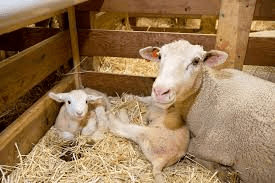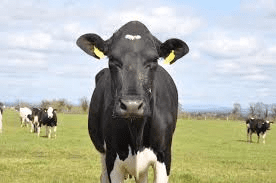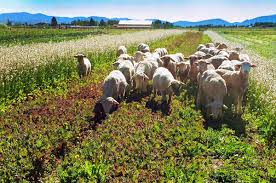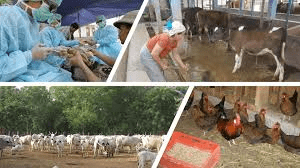Animal production systems refer to the various methods and practices used to raise and manage livestock for food, fiber, and other animal products. These systems are essential in meeting the global demand for meat, milk, eggs, and other animal-based products.
Different production systems have been developed to suit various environmental, economic, and social conditions. Understanding these systems is crucial for anyone involved in animal agriculture, as it helps in making informed decisions about sustainable and efficient livestock management.
This article will explore four main types of animal production systems: Extensive, Intensive, Semi-Intensive, and Organic.
Extensive Animal Production Systems
Extensive animal production systems involve raising animals in large areas of land, where they can graze and forage naturally. This system is often used in regions with abundant land but limited resources for intensive farming. Here are the key features and benefits of extensive systems:
1. Large Land Areas: In extensive systems, animals are typically raised on vast areas of land, such as open rangelands, pastures, or natural grasslands. This allows the animals to graze freely, which is their natural behavior.
2. Low Input Costs: Extensive systems usually require fewer inputs, such as feed, housing, and veterinary care, compared to more intensive systems. Animals primarily rely on natural vegetation for their diet, reducing the need for purchased feed.
3. Natural Environment: Animals in extensive systems live in a more natural environment, which can lead to better animal welfare. They have more space to move around, socialize, and exhibit natural behaviors.
4. Sustainable Practices: Extensive systems can be more sustainable, especially when managed properly. Grazing animals can help maintain healthy ecosystems by controlling vegetation and promoting biodiversity.
5. Challenges: Despite the benefits, extensive systems have challenges, such as lower productivity, vulnerability to weather changes, and potential overgrazing if not managed carefully. Productivity per animal may be lower due to less controlled feeding and health management.
6. Examples: Common examples of extensive systems include cattle ranching in the United States, sheep farming in Australia, and goat herding in parts of Africa and the Middle East.
Intensive Animal Production Systems

Intensive animal production systems focus on maximizing productivity by raising a large number of animals in confined spaces with high levels of management. This system is common in areas where land is limited but there is a high demand for animal products.
1. High Density of Animals: In intensive systems, animals are kept in confined spaces, such as feedlots, poultry houses, or pig pens. This allows for close monitoring and management of the animals.
2. High Input Costs: Intensive systems require significant inputs, including high-quality feed, housing, healthcare, and labor. The goal is to optimize growth rates, feed conversion, and overall productivity.
3. Controlled Environment: The environment in intensive systems is carefully controlled to ensure optimal conditions for animal growth. This includes temperature regulation, ventilation, lighting, and sanitation.
4. Increased Productivity: Intensive systems are designed to maximize production efficiency. Animals are typically fed formulated diets to promote rapid growth, leading to higher output per unit of land or resources.
5. Challenges: While intensive systems can be highly productive, they also present challenges, such as animal welfare concerns, higher environmental impact due to waste management, and the potential for the spread of diseases in confined spaces.
6. Examples: Examples of intensive systems include broiler chicken production in poultry houses, pig farming in confinement operations, and dairy farming in large-scale milking facilities.
Semi-Intensive Animal Production Systems
Semi-intensive animal production systems combine elements of both extensive and intensive systems. This approach seeks to balance the benefits of natural grazing with the productivity gains of more controlled management.
1. Combination of Grazing and Supplementary Feeding: In semi-intensive systems, animals graze on pasture but are also provided with supplementary feed, especially during times when natural forage is scarce. This helps maintain productivity while allowing animals to exhibit natural grazing behaviors.
2. Moderate Input Costs: Semi-intensive systems require more inputs than extensive systems but less than fully intensive systems. This includes moderate investments in feed, housing, and healthcare.
3. Improved Productivity: By combining natural grazing with supplementary feeding, semi-intensive systems can achieve higher productivity than extensive systems while still maintaining some of the benefits of natural grazing.
4. Flexibility: Semi-intensive systems are flexible and can be adapted to different environmental conditions. Farmers can adjust the balance between grazing and supplementary feeding based on available resources and seasonal changes.
5. Challenges: Semi-intensive systems require careful management to balance grazing and feeding, prevent overgrazing, and manage animal health. There can also be challenges in maintaining the right balance between productivity and sustainability.
6. Examples: Examples of semi-intensive systems include mixed farming operations where cattle or sheep graze during the day and are fed supplementary feed in the evening, or smallholder farms where animals are allowed to graze but also receive feed supplements.
Read Also: 15 Medicinal Health Benefits of Salvia yangii (Russian Sage)
Organic Animal Production Systems

Organic animal production systems focus on raising animals in a natural and sustainable manner, following strict guidelines to ensure animal welfare and environmental health. Organic farming is based on principles that avoid synthetic inputs and emphasize natural processes.
1. Natural Feed and Forage: Animals in organic systems are fed organic feed and have access to pasture or forage. Synthetic fertilizers, pesticides, and genetically modified organisms (GMOs) are not allowed in organic production.
2. No Antibiotics or Hormones: Organic farming prohibits the use of antibiotics and growth hormones. If animals become sick, natural remedies or other approved methods must be used for treatment.
3. Focus on Animal Welfare: Organic systems prioritize animal welfare, ensuring that animals have access to outdoor space, fresh air, and natural light. Housing conditions must allow for natural behaviors, such as grazing, rooting, or scratching.
4. Environmental Sustainability: Organic farming practices aim to protect and enhance the environment. This includes promoting biodiversity, improving soil health, and reducing pollution. Organic farms often use crop rotation, composting, and other practices to maintain soil fertility and reduce environmental impact.
5. Certification and Standards: Organic farms must meet specific standards and obtain certification from recognized organizations. This certification ensures that the farm adheres to organic principles and practices.
6. Challenges: Organic farming can be challenging due to higher production costs, lower yields compared to conventional systems, and the need for careful management to prevent disease and ensure animal health.
7. Examples: Examples of organic systems include organic dairy farms where cows graze on certified organic pastures, organic poultry farms where chickens have access to organic feed and outdoor areas, and organic sheep farming focused on natural grazing and wool production.
Read Also: Apple Maggot: Description, Damages Caused, Control and Preventive Measures
Integrated Animal Production Systems

1. Crop-Livestock Integration: This system combines crop farming with animal husbandry, allowing animals to graze on crop residues while their manure is used to fertilize crops. The integration enhances nutrient cycling, reduces waste, and improves soil fertility, leading to better overall farm productivity. For example, a farm where cows graze on pastures and crop residues while their manure is used to fertilize fields growing corn or soybeans showcases this integration.
2. Agroforestry Systems: Agroforestry involves integrating trees and shrubs with animal production. Animals graze or browse in areas where trees and crops are cultivated. This approach provides additional income from tree products such as fruit and timber, improves soil health, and supports biodiversity. Trees offer shade and shelter to livestock, which can benefit from the canopy. An example is a farm where goats graze under a canopy of fruit trees, benefiting from both the shade and fallen fruit.
3. Aquaculture-Animal Integration: This system merges fish farming with livestock production, utilizing waste from livestock to fertilize aquaculture ponds and fish waste to fertilize crops. This closed-loop system improves resource efficiency and reduces waste, enhancing the sustainability of both livestock and fish farming. For instance, a farm where fish ponds are fertilized with manure from chickens or pigs, and fish waste is used to fertilize crops grown on the farm, illustrates this integration.
4. Mixed Farming Systems: Mixed farming includes raising multiple types of livestock and growing various crops on the same farm. The different farm components support each other, diversifying income sources and spreading risk. Crop residues can be used to feed animals, and animal manure can be used to fertilize crops. An example is a farm that raises cattle, poultry, and grows grains and vegetables, utilizing resources from each component to support the others.
Comparison of Different Animal Production Systems
1. Extensive vs. Intensive: Extensive systems use large land areas for grazing with minimal inputs, promoting natural behaviors and environmental sustainability but often with lower productivity. Intensive systems involve high-density confinement with controlled conditions, maximizing productivity but requiring more resources and presenting higher welfare and environmental concerns. Extensive systems are more suitable for large, open areas with lower inputs, while intensive systems are ideal for regions with limited land but high production demands.
2. Semi-Intensive vs. Organic: Semi-intensive systems balance grazing with supplementary feeding, offering higher productivity than extensive systems while maintaining some natural behaviors. Organic systems focus on natural and sustainable practices, avoiding synthetic inputs and prioritizing animal welfare and environmental health. Semi-intensive systems offer flexibility and moderate inputs, whereas organic systems adhere to stricter regulations and may have higher costs but provide significant environmental and ethical benefits.
Advantages and Disadvantages of Each System
1. Extensive Systems: Advantages include lower input costs, better animal welfare due to more natural environments, and environmental benefits such as biodiversity promotion. Disadvantages include lower productivity, vulnerability to weather changes, and potential for overgrazing if not managed properly.
2. Intensive Systems: Advantages include high productivity and efficiency, with controlled environments optimizing growth rates. Disadvantages include higher resource use, potential animal welfare issues, and increased environmental impact from waste management and emissions.
3. Semi-Intensive Systems: Advantages include improved productivity compared to extensive systems and a balance of natural grazing with supplementary feeding. Disadvantages involve the need for careful management to prevent overgrazing and ensure proper feeding balance.
4. Organic Systems: Advantages include improved animal welfare, environmental sustainability, and the avoidance of synthetic chemicals. Disadvantages include higher production costs, potentially lower yields, and the need for careful disease management and certification.
Factors Influencing the Choice of Animal Production System
1. Land Availability: The amount of land available influences the choice of system. Extensive systems are suited for large areas, while intensive systems are better for limited land with high production demands. Semi-intensive systems offer a balance, and organic systems can be adapted to various land sizes but require specific management practices.
2. Resource Availability: Availability of resources such as feed, water, and capital affects the choice of system. Intensive systems require significant resources, while extensive systems rely more on natural resources. Organic systems require organic feed and practices, influencing resource needs and availability.
3. Market Demand: Market demand for animal products impacts the choice of system. Intensive systems cater to high-demand markets with consistent production, while organic systems appeal to niche markets focused on sustainability and ethical practices. Semi-intensive systems provide a middle ground, offering versatility in production.
4. Environmental and Ethical Considerations: Environmental impact and animal welfare concerns influence system choice. Extensive and organic systems often have lower environmental impacts and better welfare conditions, while intensive systems may require more attention to mitigate negative effects. Ethical considerations and sustainability goals play a crucial role in determining the appropriate system.
Conclusion
Choosing the right animal production system involves balancing various factors, including resource availability, market demand, and environmental and ethical considerations. Extensive, intensive, semi-intensive, and organic systems each offer unique benefits and challenges.
By understanding the characteristics and impacts of each system, farmers and stakeholders can make informed decisions that align with their goals, resources, and values. Effective integration of different practices and ongoing innovation will continue to shape the future of animal production, promoting sustainability and efficiency in the industry.
Read Also: How to Grow Microgreens
Frequently Asked Questions
We will update this section soon.

